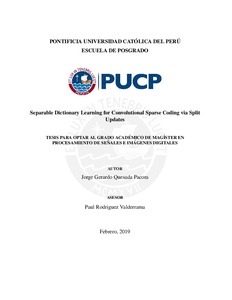| dc.contributor.advisor | Rodriguez Valderrama, Paul Antonio | |
| dc.contributor.author | Quesada Pacora, Jorge Gerardo | es_ES |
| dc.date.accessioned | 2019-05-16T22:49:22Z | es_ES |
| dc.date.available | 2019-05-16T22:49:22Z | es_ES |
| dc.date.created | 2019 | es_ES |
| dc.date.issued | 2019-05-16 | es_ES |
| dc.identifier.uri | http://hdl.handle.net/20.500.12404/14209 | |
| dc.description.abstract | The increasing ubiquity of Convolutional Sparse Representation techniques for several image processing
tasks (such as object recognition and classification, as well as image denoising) has recently
sparked interest in the use of separable 2D dictionary filter banks (as alternatives to standard nonseparable
dictionaries) for efficient Convolutional Sparse Coding (CSC) implementations. However,
existing methods approximate a set of K non-separable filters via a linear combination of R (R << K)
separable filters, which puts an upper bound on the latter’s quality. Furthermore, this implies the need
to learn first the whole set of non-separable filters, and only then compute the separable set, which is
not optimal from a computational perspective.
In this context, the purpose of the present work is to propose a method to directly learn a set of K
separable dictionary filters from a given image training set by drawing ideas from standard Convolutional
Dictionary Learning (CDL) methods. We show that the separable filters obtained by the proposed
method match the performance of an equivalent number of non-separable filters. Furthermore, the computational
performance of this learning method is shown to be substantially faster than a state-of-the-art
non-separable CDL method when either the image training set or the filter set are large. The method and
results presented here have been published [1] at the 2018 IEEE International Conference on Acoustics,
Speech and Signal Processing (ICASSP 2018). Furthermore, a preliminary approach (mentioned at the
end of Chapter 2) was also published at ICASSP 2017 [2].
The structure of the document is organized as follows. Chapter 1 introduces the problem of interest
and outlines the scope of this work. Chapter 2 provides the reader with a brief summary of the relevant
literature in optimization, CDL and previous use of separable filters. Chapter 3 presents the details of
the proposed method and some implementation highlights. Chapter 4 reports the attained computational
results through several simulations. Chapter 5 summarizes the attained results and draws some final
conclusions. | es_ES |
| dc.description.uri | Tesis | es_ES |
| dc.language.iso | eng | es_ES |
| dc.publisher | Pontificia Universidad Católica del Perú | es_ES |
| dc.rights | info:eu-repo/semantics/openAccess | es_ES |
| dc.rights.uri | http://creativecommons.org/licenses/by/2.5/pe/ | * |
| dc.subject | Procesamiento de imágenes digitales | es_ES |
| dc.subject | Electrónica--Diccionarios | es_ES |
| dc.title | Separable dictionary learning for convolutional sparse coding via split updates | es_ES |
| dc.type | info:eu-repo/semantics/masterThesis | es_ES |
| thesis.degree.name | Maestro en Procesamiento de Señales e Imágenes Digitales. | es_ES |
| thesis.degree.level | Maestría | es_ES |
| thesis.degree.grantor | Pontificia Universidad Católica del Perú. Escuela de Posgrado | es_ES |
| thesis.degree.discipline | Procesamiento de Señales e Imágenes Digitales | es_ES |
| renati.advisor.dni | 07754238 | |
| renati.discipline | 613077 | es_ES |
| renati.level | https://purl.org/pe-repo/renati/level#maestro | es_ES |
| renati.type | http://purl.org/pe-repo/renati/type#tesis | es_ES |
| dc.publisher.country | PE | es_ES |
| dc.subject.ocde | https://purl.org/pe-repo/ocde/ford#2.02.05 | es_ES |






